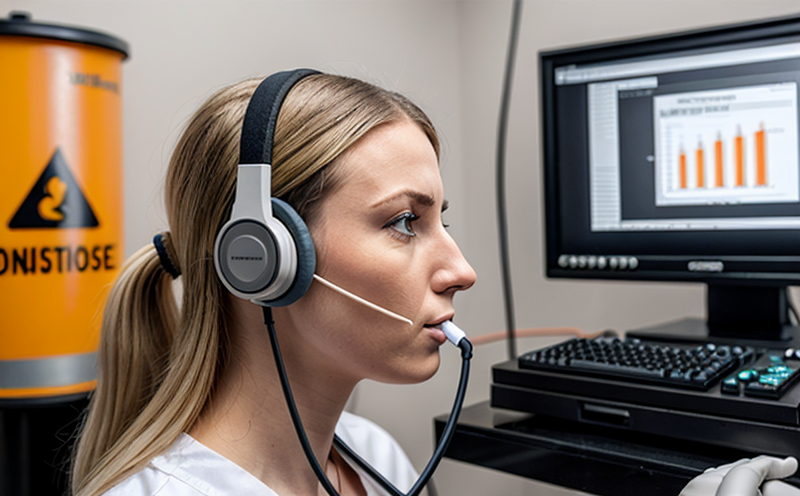EN 352-3 Helmet-Mounted Ear Protector Testing
The EN 352 series of standards provides guidelines and requirements for protective helmets, including their associated accessories such as ear protectors. Specifically, the standard EN 352-3 pertains to helmet-mounted ear protectors, ensuring they meet the necessary criteria for protecting workers against occupational noise exposure. This standard is crucial in industries where prolonged or high-intensity noise can lead to hearing damage and other adverse effects on health.
The testing procedures outlined in EN 352-3 are designed to evaluate the effectiveness of helmet-mounted ear protectors under various conditions that simulating real-world occupational scenarios. These tests include measurements of sound pressure levels, frequency response, and attenuation provided by the ear protector when worn with a helmet. The goal is to ensure that these protective devices meet or exceed specified performance criteria, thereby providing reliable hearing protection.
The methodology involves precise calibration and testing in controlled environments to simulate actual workplace conditions. Testers place the ear protectors on helmets according to specific protocols detailed within the standard. Sound sources are then used to generate various noise levels at different frequencies, simulating potential hazards encountered by workers across diverse industries. Data collected during these tests helps assess how well the ear protector reduces unwanted sound while maintaining communication capabilities essential for safe working practices.
In addition to laboratory evaluations, field trials may also be conducted where possible to verify the effectiveness of the protective equipment under real-world conditions. This comprehensive approach ensures that the products not only meet theoretical standards but also perform effectively in practical situations. Compliance with EN 352-3 helps manufacturers ensure their helmet-mounted ear protectors provide adequate protection against occupational noise exposure, contributing significantly to worker safety and health.
By adhering strictly to this standard, companies can demonstrate their commitment to employee well-being by offering high-quality protective gear that meets international benchmarks. This not only enhances reputation but also ensures compliance with regulations set forth by governing bodies like OSHA or EU directives related to workplace safety.
Scope and Methodology
The scope of EN 352-3 focuses on the performance requirements for helmet-mounted ear protectors (HEPs) used in conjunction with personal protective equipment (PPE). The standard aims to ensure that HEPs provide adequate attenuation against noise levels encountered during occupational activities. It specifies detailed testing procedures and acceptance criteria designed to evaluate both passive and active noise reduction systems.
Testing begins by selecting appropriate sound sources capable of generating wideband noise within the frequency range relevant to human hearing, typically between 20 Hz and 16 kHz. These sources are positioned at designated locations around the headform simulating typical workplace environments where workers might be exposed to hazardous sounds.
A calibrated microphone is attached close to the ear canal of the headform to measure transmitted sound pressure levels through the HEPs. Simultaneously, another microphone placed outside the helmet records ambient noise without any protective measures in place. By comparing these two sets of data, it becomes possible to quantify the amount of noise reduction provided by the HEP.
Additional measurements are made regarding communication capabilities ensured by the ear protectors when worn with helmets. This ensures that workers can still communicate effectively even while being protected against high-intensity noises. The standard also includes provisions for testing under dynamic conditions simulating actual usage patterns, ensuring robust performance over time.
Industry Applications
The application of EN 352-3 helmet-mounted ear protector testing extends across numerous industries where occupational noise exposure poses significant risks. Construction sites, manufacturing plants, mining operations, and various other sectors often require robust hearing protection solutions that comply with international standards.
In the construction industry, workers frequently face prolonged periods of high-intensity noise from machinery such as jackhammers or power tools. Properly fitted helmet-mounted ear protectors can help mitigate these risks, ensuring long-term auditory health among laborers. Similarly, in manufacturing environments, continuous exposure to machinery produces consistent levels of noise that could lead to hearing loss if left unprotected.
For mining operations, where underground excavations and heavy equipment operation create intense vibrations accompanied by loud noises, suitable ear protection becomes indispensable for safeguarding miners' ears from permanent damage. Compliance with EN 352-3 guarantees that the chosen protectors offer sufficient attenuation against these challenging conditions.
Beyond physical harm reduction, compliance with this standard also contributes positively to corporate image and regulatory compliance efforts. It demonstrates a company's dedication to worker safety and adherence to global standards. Additionally, it facilitates smoother interactions between companies involved in international trade since meeting such internationally recognized specifications can simplify certification processes across different countries.
Competitive Advantage and Market Impact
Adhering to EN 352-3 helmet-mounted ear protector testing offers several advantages for businesses operating in competitive markets. First, it enhances product quality by ensuring that protective equipment meets rigorous international standards, thereby increasing consumer trust and satisfaction.
Compliance with this standard can also serve as a strong selling point, differentiating products from competitors who may not adhere to such stringent specifications. Companies demonstrating commitment to worker safety through compliance are more likely to attract customers prioritizing ethical business practices.
In terms of regulatory compliance, meeting EN 352-3 requirements ensures that companies remain up-to-date with evolving industry norms and legal obligations. This proactive approach helps avoid potential penalties associated with non-compliance while maintaining a positive standing among regulators.
The standard's emphasis on both passive and active noise reduction systems allows manufacturers to innovate within defined parameters, fostering creativity in developing advanced hearing protection solutions tailored specifically for various applications. Such innovation can lead to improved product features such as better comfort, enhanced communication capabilities, or more effective sound attenuation.
Moreover, compliance with this standard positions companies favorably in terms of market reputation and potential business growth opportunities. It opens doors to new markets where stringent safety requirements are enforced but also paves the way for expanded presence within existing markets through increased brand loyalty among customers prioritizing product quality and worker safety.





